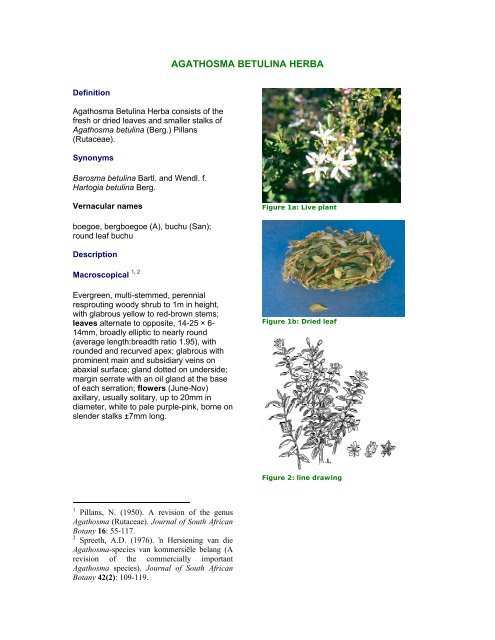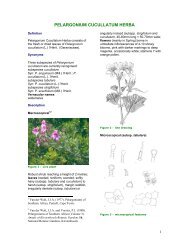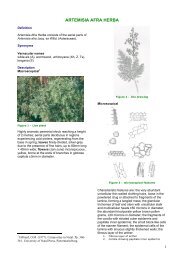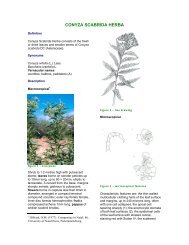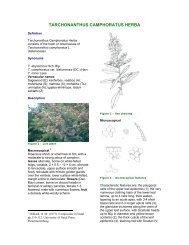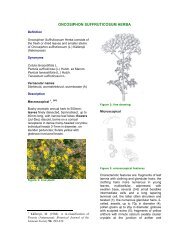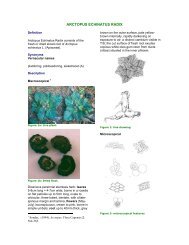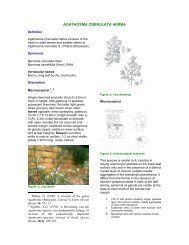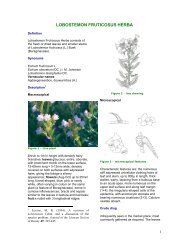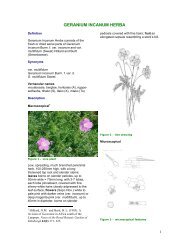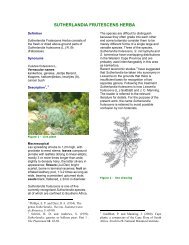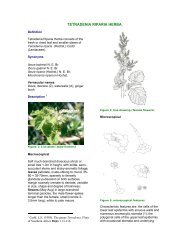AGATHOSMA BETULINA HERBA - PlantZAfrica
AGATHOSMA BETULINA HERBA - PlantZAfrica
AGATHOSMA BETULINA HERBA - PlantZAfrica
Create successful ePaper yourself
Turn your PDF publications into a flip-book with our unique Google optimized e-Paper software.
<strong>AGATHOSMA</strong> <strong>BETULINA</strong> <strong>HERBA</strong><br />
Definition<br />
Agathosma Betulina Herba consists of the<br />
fresh or dried leaves and smaller stalks of<br />
Agathosma betulina (Berg.) Pillans<br />
(Rutaceae).<br />
Synonyms<br />
Barosma betulina Bartl. and Wendl. f.<br />
Hartogia betulina Berg.<br />
Vernacular names<br />
Figure 1a: Live plant<br />
boegoe, bergboegoe (A), buchu (San);<br />
round leaf buchu<br />
Description<br />
Macroscopical 1, 2<br />
Evergreen, multi-stemmed, perennial<br />
resprouting woody shrub to 1m in height,<br />
with glabrous yellow to red-brown stems;<br />
leaves alternate to opposite, 14-25 × 6-<br />
14mm, broadly elliptic to nearly round<br />
(average length:breadth ratio 1.95), with<br />
rounded and recurved apex; glabrous with<br />
prominent main and subsidiary veins on<br />
abaxial surface; gland dotted on underside;<br />
margin serrate with an oil gland at the base<br />
of each serration; flowers (June-Nov)<br />
axillary, usually solitary, up to 20mm in<br />
diameter, white to pale purple-pink, borne on<br />
slender stalks ±7mm long.<br />
Figure 1b: Dried leaf<br />
Figure 2: line drawing<br />
1 Pillans, N. (1950). A revision of the genus<br />
Agathosma (Rutaceae). Journal of South African<br />
Botany 16: 55-117.<br />
2 Spreeth, A.D. (1976). ʼn Hersiening van die<br />
Agathosma-species van kommersiële belang (A<br />
revision of the commercially important<br />
Agathosma species). Journal of South African<br />
Botany 42(2): 109-119.
Microscopical 3<br />
Crude drug<br />
Collected as required or available in the<br />
marketplace as bundles of leafy twigs with<br />
light yellow-green, highly aromatic foliage;<br />
texture soft when fresh, leathery when dry;<br />
occasional flowers may be present. BPC<br />
quality buchu leaf is freely available in<br />
pharmacies in South Africa and<br />
unstandardised leaf in supermarkets.<br />
Geographical distribution<br />
Sandy mountain slopes of the Western<br />
Cape Province, in the Calvinia, Cedarberg,<br />
Tulbagh, Ceres and Piketberg districts, at<br />
altitudes of 300-700m above sea level.<br />
Figure 3: microscopical features<br />
1. Cells of the upper leaf epidermis<br />
2. Cells of the lower leaf epidermis with<br />
anomocytic stomata<br />
3. Cells of upper leaf epidermis in sectional view<br />
showing unicellular warty clothing hair<br />
4. Cells of lower leaf epidermis with clothing hair<br />
5. Cells of upper leaf epidermis (sectional view)<br />
containing sphaerocrystalline masses of<br />
diosmin<br />
6. Cells of the petiole<br />
7. Cells of the mesophyll containing cluster<br />
crystals (rosette aggregates) of calcium<br />
oxalate<br />
Characteristic features are: the polygonal<br />
cells of the upper leaf epidermis with slightly<br />
thickened walls, some containing<br />
sphaerocrystalline pale yellow masses of<br />
diosmin; the smaller thin-walled polygonal<br />
cells of the lower leaf epidermis; the<br />
numerous anomocytic stomata of the lower<br />
leaf surface only; occasional unicellular<br />
warty covering trichomes of leaf and petiole,<br />
each up to 300µ in length; the cells of the<br />
leaf mesophyll containing calcium oxalate<br />
cluster crystals, each up to 80µ in diameter;<br />
the spherical schizo-lysigenous oil glands of<br />
the mesophyll containing oil droplets<br />
staining red with Soudan IV solution; the<br />
fibres accompanying the leaf midrib and<br />
main veins.<br />
Figure 4: distribution map<br />
Quality standards<br />
Identity tests<br />
Thin layer chromatography on silica gel<br />
using as solvent a mixture of toluene:diethyl<br />
ether:1.75M acetic acid (1:1:1). Reference<br />
compound cineole (0, 1% in chloroform).<br />
Method according to Appendix 2a.<br />
Note The methods used for thin layer<br />
chromatography and HPLC gave poor<br />
results for this species. Further work is<br />
required.<br />
HPLC on C 18 column, method according to<br />
Appendix 2b.<br />
Water-soluble extractive value: not less than<br />
14% 3<br />
Volatile oil content: not less than 1.3% 3; not<br />
less than 1.8% 4<br />
3 British Herbal Medicine Association (1996).<br />
Buchu. pp. 46-47 in: British Herbal<br />
Pharmacopoeia, Biddles Ltd., King’s Lynn.<br />
4 British Pharmaceutical Codex (1963).<br />
Pharmaceutical Society of Great Britain, Lund<br />
Humphries, London.
Stems: not more than 5% 3, 4<br />
Total ash: not more than 5% 3, 4<br />
Purity tests<br />
Assay<br />
None available. Assay methods for buchu oil<br />
have been published. 5-7<br />
Major chemical constituents<br />
Apart from the common flavonoids rutin and<br />
diosmin, the foliage of A. betulina contains<br />
1.5-2.5% 3, 4 of an essential oil of which the<br />
main constituents are<br />
menthone/isomenthone (29.83-60.0%), (ψ)-<br />
diosphenol/diosphenol (9.46-40.88%),<br />
limonene (11.6-17.0%),<br />
pulegone/isopulegone (7.0-34.1%) and both<br />
cis- and trans-8-mercapto-p-menthane-3-<br />
ones (±3%) 5, 6,<br />
7 . The latter are said to<br />
contribute most to the characteristic odour of<br />
the oil, reminiscent of blackcurrants (see d<br />
below).<br />
Figure 7: chemical constituents<br />
Dosage forms<br />
In traditional practice, A. betulina is most<br />
commonly taken orally in the form of an<br />
aqueous infusion, sometimes sweetened<br />
with brown sugar, or as a tincture in brandy.<br />
Other dosage forms include a vinegar<br />
infusion, for external application as an<br />
GR1, 11 and 21-<br />
antiseptic wash or embrocation.<br />
24<br />
5 Kaiser, R., Lamparsky, D. and Schudel, P.<br />
(1975). Analysis of buchu leaf oil. Journal of<br />
Agricultural and Food Chemistry 23(5): 943-<br />
950.<br />
6<br />
Blommaert, K.L.J. and Bartel, E. (1976).<br />
Chemotaxonomic aapects of the buchu series<br />
Agathosma betulina Pillans and A. crenulata<br />
Pillans from local plantings. Journal of South<br />
African Botany 42(2): 121-126.<br />
7 Posthumus, M.A. van Beek, T.A., Collins, N.F.<br />
and Graven, E.H. (1996). Chemical composition<br />
of the essential oils of Agathosma betulina, A.<br />
crenulata and an A. betulina × crenulata hybrid<br />
(Buchu). Journal of Essential Oil Research 8:<br />
223-228.<br />
Buchu was introduced into Britain in 1790<br />
and in 1821 included in the British<br />
Pharmacopoeia (BP); later also in the British<br />
Pharmaceutical Codex (BPC). It remained<br />
an official remedy until 1963; dosage forms<br />
included a concentrated infusion (BPC<br />
1954) and a tincture (BPC 1949). Various<br />
mixtures were listed in formularies current at<br />
the time e.g. Mistura Buchu et Hyoscyamus<br />
(British National Formulary 1939) and<br />
Compound Buchu Mixture (Chelsea Hospital<br />
for Women).<br />
In Europe, a number of patent remedies<br />
containing buchu e.g. teas, dragees and<br />
drops are available for self medication GR8 .<br />
Medicinal uses
Buchu, originally a highly prized San and<br />
Khoi-khoi traditional remedy, has remained<br />
one of the most popular herbal medicines in<br />
South Africa. Its traditional use<br />
encompasses the treatment of kidney and<br />
urinary tract infections, colds, stomach<br />
ailments, rheumatism, gout and fever.<br />
Externally it is applied as an antiseptic wash<br />
to infected wounds and as a compress to<br />
GR1, 11<br />
relieve swelling, bruising and sprains<br />
and 19-24 . Combinations of buchu with wilde<br />
als (Artemisia afra) or wilde knoffel<br />
(Tulbaghia spp.) are commonly taken for<br />
colds and influenza or as a general tonic.<br />
Buchu was described in the BP and BPC as<br />
a weak diuretic and urinary tract antiseptic<br />
for the treatment of urethritis, cystitis and<br />
prostatitis. These are its recommended uses<br />
in Europe at the present time 8, 9 GR 6, 7, 8,<br />
and<br />
10.<br />
Pharmacology/bioactivity<br />
In vitro tests of both aqueous/alcoholic<br />
extracts and of volatile oil demonstrated little<br />
antimicrobial activity against common<br />
urinary tract pathogens GR7 . A more recent<br />
study showed the essential oil (10µl/well) to<br />
possess weak antimicrobial activity against<br />
Escherichia coli, Staphylococcus aureus and<br />
Saccharomyces cerevisiae but none against<br />
Enterococcus hirae and Pseudomonas<br />
aeruginosa 10 . In the same study, initial<br />
smooth muscle spasmogenic activity<br />
(guinea pig ileum), followed by spasmolysis,<br />
was demonstrated for the essential oil<br />
(concentration range 4×10 -6 to 8 ×10 -5 v/v in<br />
methanol). Spasmolytic action was dose<br />
related, with an IC50 of 8×10 -6 .<br />
In an in vitro assay, aqueous leaf extracts<br />
showed no antiviral activity (cell culture)<br />
against Herpes Virus Type 2, Influenza Virus<br />
8 Pharmacopée Française, Xe édition (1983). See<br />
also Bulletin Officiel No. 90/22 bis: Buchu,<br />
feuille<br />
9 German Kommission E monograph (published<br />
1/2/1990): Barosmae folium (Buccoblätter)<br />
10 Lis-Balchin, M. and Simpson, S.H. (2001).<br />
Buchu (Agathosma betulina and A. crenulata,<br />
Rutaceae) essential oils: their pharmacological<br />
action on guinea pig ileum and antimicrobial<br />
activity on micro-organisms. Journal of<br />
Pharmacy and Pharmacology 53(4):579-582.<br />
A2 (Manheim 57), Poliovirus II or Vaccinia<br />
Virus 11 . In this study no cytotoxic activity<br />
aginst HeLa cells was shown. Antimutagenic<br />
activity of an aqueous leaf infusion was<br />
assessed in vitro (Salmonella typhimurum<br />
TA 98 and TA 100) against ethyl<br />
methanesulphonate- and amino anthraceneinduced<br />
mutagenicity, but no activity could<br />
be demonstrated 12 . In vivo anti-inflammatory<br />
activity has been demonstrated for diosmin<br />
(isolated from the overground parts of the<br />
plant), which reduced carrageenan-induced<br />
rat paw oedema at a dose of 600mg/kg body<br />
weight. Other animal studies appear to be<br />
lacking.<br />
Contraindications<br />
Owing to the variable composition of buchu<br />
essential oil, particularly in respect of<br />
pulegone levels (see 9.0 above), the use of<br />
buchu preparations during pregnancy and<br />
lactation is contraindicated.<br />
Adverse reactions<br />
Traditional practitioners report gastrointestinal<br />
irritation as a possible side effect<br />
of oral use. Buchu preparations should<br />
therefore be used with caution by patients<br />
suffering from kidney infections,<br />
haemorrhoids or irritable bowel syndrome.<br />
See also GR 6-8.<br />
Precautions<br />
Prolonged or excessive use of this herb is<br />
not advisable.<br />
Dosage<br />
Dried leaf: 1-2 g (± 1-2 teaspoonsful<br />
powdered leaf) by infusion, three times daily.<br />
An infusion may be prepared by adding<br />
600ml of boiling water to 30g of powdered<br />
11 May, G. and Willuhn, G. (1978). Antiviral<br />
activity of aqueous extracts from medicinal<br />
plants in tissue cultures. Arzneimittel-Forschung.<br />
28(1): 1-7.<br />
12 Badria, F. A. (1994). Is man helpless against<br />
cancer? An environmental approach:<br />
antimutagenic agents from Egyptian food and<br />
medicinal preparations. Cancer Letters 84 (1): 1-<br />
5.
drug and allowing to stand in a covered<br />
vessel for 30 minutes. The resultant infusion<br />
is strained and stored in the refrigerator; to<br />
be taken in 30-60ml (2-4 tablespoonsful)<br />
doses, three times daily, diluted with plenty<br />
of water.<br />
Concentrated Buchu Infusion BPC 1954<br />
(1:2.5 prepared by percolation with 25%<br />
ethanol): 4-8ml<br />
Liquid extract (1:1 in 90% ethanol ): 0.3-1.2<br />
ml<br />
Buchu Tincture BPC 1949 (1:5 prepared<br />
by percolation in 60% ethanol): 2-4ml<br />
Food use<br />
Buchu oil has been approved in the USA as<br />
a food flavouring agent, at concentrations of<br />
up to about 0.002% (15.4 ppm). The oil is<br />
also listed by the Council of Europe as a<br />
natural source of food flavouring (category<br />
N3) GR17<br />
Copyright in this monograph resides with the authors, the South<br />
African National Biodiversity Institute, the South African Medical<br />
Research Council and the University of the Western Cape. It may<br />
not be reproduced in whole or in part without the written consent of<br />
the copyright holders.


